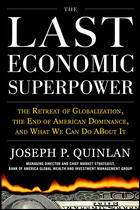 Have you found yourself wondering over the past couple of years just how the Great Recession came about? What sorts of things led up to this meltdown, and how far in advance did it all start? What might we do in the future to keep something similar from happening again?
Have you found yourself wondering over the past couple of years just how the Great Recession came about? What sorts of things led up to this meltdown, and how far in advance did it all start? What might we do in the future to keep something similar from happening again?
In his book, The Last Economic Superpower, Joseph P. Quinlan does a wonderful job of answering those questions and many, many, more. While the text does get long on statistics and therefore a bit technical to comprehend, I think Quinlan has done an excellent job overall of walking the reader through the precursors to the crisis, the crisis itself, and what our present situation looks like as a result.
The first section of the book covers all the events leading up to the late-2008 global economic crisis, tracing issues back to the very roots of the rise of globalization after World War II, then specifically pointing out how the Nixon administration’s elimination of the gold standard in 1971, finally examining how Ronald Reagan’s economic policies helped to usher in the economic globalization that we experienced between 1983 and 2008. All of these events are put into context with the 2008 economic crisis.
After the precursors have been reviewed, Quinlan examines the actual meltdown itself and what it means to all countries across the globe. Not only does he explain the impacts that the US has endured, but he also takes time to explain the impacts to many EU members, China, Brazil, Russia, India and many other emerging economies. He also explains the ascent of the G-20 over the original G-7 (or G-8), and how this will likely impact the global economy going forward.
But then Quinlan takes things a step further, dusting off his crystal ball. The final two chapters of the book review two different paths that the global economy could take – away from globalization (similar to the post-WWI era), where each nation fends for themselves and continues on a path toward isolation; or toward globalization, led by the only remaining economic superpower (the US), the new players of the global economic stage (China, India, Russia and Brazil), and our long-time economic partners in the EU, with an eye to bettering the overall world, not just each individual nation’s needs.
Each chapter offers compelling facts that make either outcome seem plausible. Recent events in the Middle East (since the writing of this book) have seemed to give opportunities for the rest of the global community to begin acting out one scenario or the other – and it remains to be seen just how things will work out.
I really enjoyed this book – but I’m a financial geek. I suspect if you’re not as interested in these matters as I am on a day-to-day basis, you may find the book somewhat long on technical statistics, facts, and figures, but I felt like that information was important to the subject. If you’re at all interested in a good overview of the global economic situation of recent years and what the outcome could be for the US and the world, I think you should give this book a read. Not only is it helpful to understand the how and why of the 2008 crisis, but it will also help you to understand how investing today must include international exposure – not only in developed and emerging market equities, but also in the fixed income (credit) markets.
The above book review is part of a series of reviews that I am doing in an arrangement with McGraw-Hill Professional Publishing, where MH sends me books with the only requirement being that I read the book and write a review – like it or not. If you find the information in this review useful, let me (and McGraw-Hill) know!



 Sterling Raskie, MSFS, CFP®, ChFC®
Sterling Raskie, MSFS, CFP®, ChFC® The latest in our Owner’s Manual series, A 401(k) Owner’s Manual, was published in January 2020 and is available on
The latest in our Owner’s Manual series, A 401(k) Owner’s Manual, was published in January 2020 and is available on  A Medicare Owner’s Manual, is updated with 2020 facts and figures. This manual is available on
A Medicare Owner’s Manual, is updated with 2020 facts and figures. This manual is available on  Social Security for the Suddenly Single can be found on Amazon at
Social Security for the Suddenly Single can be found on Amazon at  Sterling’s first book, Lose Weight Save Money, can be
Sterling’s first book, Lose Weight Save Money, can be  An IRA Owner’s Manual, 2nd Edition is available for purchase on Amazon. Click the link to choose the
An IRA Owner’s Manual, 2nd Edition is available for purchase on Amazon. Click the link to choose the  Jim’s book – A Social Security Owner’s Manual, is now available on Amazon. Click this link for the
Jim’s book – A Social Security Owner’s Manual, is now available on Amazon. Click this link for the  And if you’ve come here to learn about queuing waterfowl, I apologize for the confusion. You may want to discuss your question with Lester, my loyal watchduck and self-proclaimed “advisor’s advisor”.
And if you’ve come here to learn about queuing waterfowl, I apologize for the confusion. You may want to discuss your question with Lester, my loyal watchduck and self-proclaimed “advisor’s advisor”.